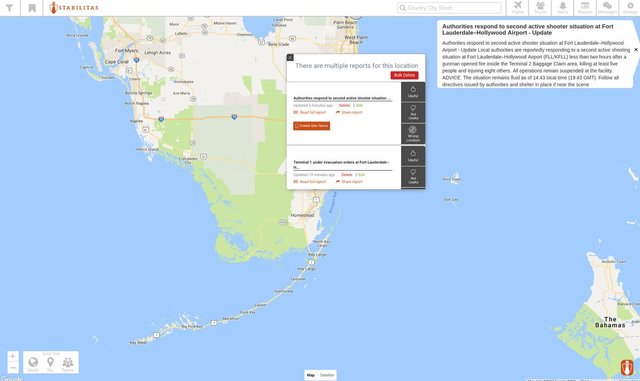
Security managers are overloaded. From cybersecurity to airline safety, security managers deal with a flood of information on a daily basis. Finding useful intelligence in all the noise is truly a needle-in-the-haystack problem. To make matters worse, the sheer volume of information from raw data sources like Twitter makes false reports significantly harder to identify and debunk.
In the recent shooting at the Fort Lauderdale airport, reports propagated through social media spread the rumor that there was a second active shooter in a nearby parking garage. Combined with breakdowns in emergency communication systems, the result was confusion and chaos.
#FortLauderdale
🌍 Muschelschloss ☕ (@Muschelschloss) January 6, 2017
"Police swarm 2. story of Terminal 2 parking garage at #FLL telling us to duck for cover after reports of second incident." https://t.co/Vw5nn3G0vl
Police swarm second story of Terminal 2 parking garage at #FLL telling us to duck for cover after reports of second incident. @wsvn pic.twitter.com/00eqjFO5g1
Joe Roetz 7News (@JoeRoetz) January 6, 2017
Witnesses said they could see police running towards the garage with weapons drawn. Reports were coming in from live broadcasts and streaming video from people on the ground. Our own Twitter feed pushed out this same information:
UPDATE: Authorities respond to second active shooter situation at #FortLauderdale - Hollywood Airport pic.twitter.com/xBifSqhR44
Stabilitas (@StabilitasV) January 6, 2017

Why? Simply put, it was relevant information. “But the report was wrong,” you say!
That’s true, but here’s why that’s only part of the problem.
In dynamic events like the Fort Lauderdale shooting, the initial shock of the first few minutes is followed by a scramble to make sense of what happened and determine if there is a further threat. Communication during these times is characterized by two key qualities: speed and accuracy.
If information comes in too slowly, it won’t matter how accurate it is, as people on the ground will be forced to act with limited information or risk being overcome by events. On the other hand, information without corroboration may be fast, but it can also lead to errors. In a crisis, accurate information in real time is invaluable.
Like the post we shared above, we had timely information, but it wasn’t accurately confirmed or verified. This is where things started to go wrong. The capacity for information flow is so high, and the potential threat of a multiple-shooter scenario so severe, that this inaccurate information quickly sparked a panic.
The rapid flow of information can be both a blessing and a curse. At Ft. Lauderdale, the tidal wave of reports about the “second shooter” drowned out the all-clear and, in hindsight, sent the security response off the rails.
So how can we fix the problem? More data generally leads to better decisions as long as there isn’t overload, so simply limiting sources of information is not the best solution. But in a crisis, it’s easy for critical details to be missed or for events to spiral out of control.
We have two solutions that work hand-in-hand. The first is our use of machine learning algorithms to augment security professionals in intelligence analysis. These algorithms continually improve, and we can teach them things like “reports of an all-clear are just as valuable as reports of an active shooter,” as well as how to prioritize information based off timeliness and quality of the source. This will help highlight critical information when it’s needed most.
The second approach is clear and efficient communication management. We’re building mechanisms for reliable, redundant, and auditable communications to ensure that needed information is distributed as fast as possible. Combining these systems for intelligence analysis and mass communication gives security professionals the ability to act quickly and confidently.
Law enforcement at Ft. Lauderdale decided to close the airport based off false reports of a serious threat to airport safety. We won’t second guess that decision.
Many of us at Stabilitas are military veterans and understand the nature of decision-making in chaotic environments. Rather, we want to explain how we’re learning from events like this one to make our tools better and our world safer. Stabilitas users demand the intelligence and communication tools to overcome the speed vs. accuracy dilemma altogether.
nicely put. as a writer on security (mainly the political side of security), I'd like to see more of this kind of article.
followed
Downvoting a post can decrease pending rewards and make it less visible. Common reasons:
Submit